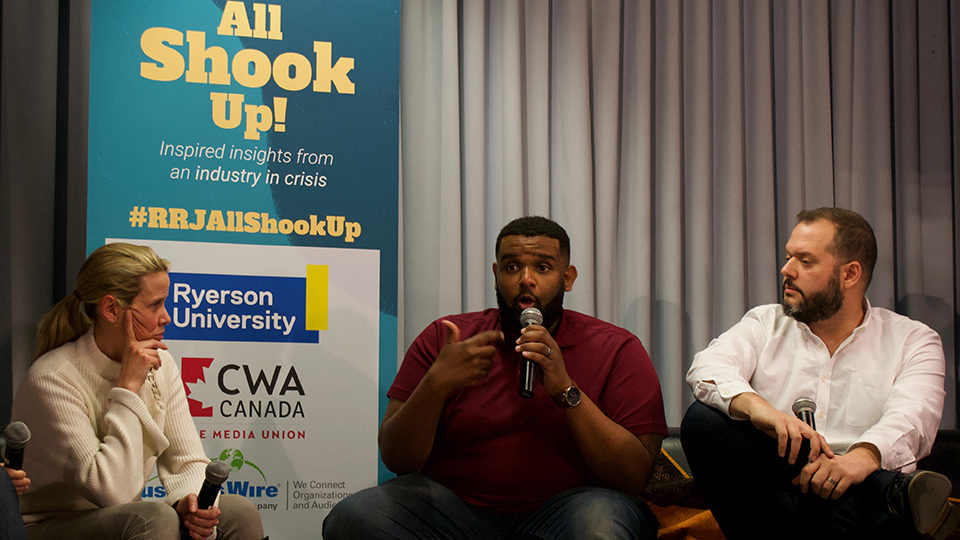The news is making us feel sick, explained Jesse Brown, host and publisher of Canadaland, to a packed house attending RRJ Unpublished: Journalism All Shook up!
“People are legitimately feeling biological, physiological effects of news consumption. We’re hurting people.” Brown joined six panelists at The Ryerson Review of Journalism’s second RRJUnpublished event of the 2018-2019 school year on Tuesday, March 19. The event, which took place at the Venn, brought industry professionals together for a conversation about finding inspiration within the grim media industry landscape.
“Every headline is trying to elbow other headlines out of the way and everything is incredibly, screamingly important,” said Brown. “We can insist we are good for you, but we are making people sick.” And, Brown said, this is something new, and something we need to look at. “[Because] we used to make people feel good.”
Feeling good about an often intimidating and stressful news cycle was a recurring topic that each speaker addressed through various mediums. Elamin Abdelmahmoud, news curation and social media editor at BuzzFeed News, cited that making audiences feel personally addressed and engaged is key, calling newsletters “the most personal medium of all the social platforms.”
The BuzzFeed News morning newsletter, which Abdelmahmoud writes every morning at 4 a.m. with a distinct yet uncomplicated first-person voice, is connecting with readers in a way many other digital mediums aren’t. The newsletter acts as a “news buddy,” so to speak, informing the audience of the news in a colloquial, friendly tone.
“I’ve got a lot of emails from readers who say, ‘look, your newsletter is one of the best parts of my morning and the reason is because it doesn’t make me feel stupid or mad at catching up on the news,’” he said.
For Annabel Soutar, artistic and executive director of the documentary theatre company Porte Parole, her plays use journalistic practices in order to tackle complicated stories in a way that is more immersive than traditional journalism. “I’m really trying to create a space where different sides can encounter each other,” she said, explaining how plays can engage with both the audience’s intellect and heart. It’s because of this new approach to journalism, she said, that her current touring production, J’aime Hydro is selling out thousand-seat shows across Quebec.
William Wolfe-Wylie, senior developer, news interactives and data for CBC discussed how his job is to “perform acts of journalism through code instead of prose” and outlined the ways coding and data is crucial to bettering the reporting in a story. Wolfe-Wylie worked on CBC’s “Crying Out For Care,” a year-long investigation into the rising number of abuse incidents in long term care homes in Ontario; an investigation that saw Wolfe-Wylie sifting through around 11,000 pages of PDF FOI’s (Freedom of Information).
“We are responsible to the journalists and we get called in when things are a bit too weird, and we get to have fun with that side of things,” he said. “Sometimes we’re doing research, sometimes we’re mining FOI’s and helping reporters do their job so they know the right questions to ask…all of it comes down to figuring out what technology we want to use in the moment and writing code that performs acts of journalism.”
During the panel discussion, Soutar talked about how new forms of journalism such as documentary theatre and podcasts are flourishing due to innovation spurred from the market fragmentation of the media industry. Hannah Hoag, energy and environment editor of The Conversation Canada, said this market fragmentation is allowing new, smaller organizations to “focus on what they know best and the communities they know best.”
San Grewal, who founded Brampton’s local news publication The Pointer in 2018 believes that local news has an important role to play in the current state of media fragmentation. Grewal used the example of the recent NAFTA negotiations, where most major publications wrote about the topic on a federal level.
Brampton, home to a large aluminium and automotive industry, would be greatly affected by these talks but wasn’t being covered. As a local news organization, The Pointer was able to talk directly to members of the community, writing stories that resonated more deeply with its readers.
“A lot of the stories that we deal with today, it’s felt at the local level,” said Grewal, who said that his research consistently shows that local coverage is what audiences really want. Grewal believes there’s hope in spite of the last decade of disruption in journalism.
“More platforms are going to emerge, a lot of legacies are going to die. People are restless,” said Grewal. “But that’s a good thing.”
In addition to the personable and humanistic pulls of podcasts and newsletters that have the ability to make audiences excited about the news, Brown noted that one solution to the seemingly imminent doom of the journalism industry is by making people “feel good about being engaged.” Brown referred to Canadaland’s own subscribers who, by paying into quality journalism, also feel like they’re a part of something more. When we consume good journalism, he said, we contribute to a civil, democratic society.
“When we break a story and something actually changes, they did that,” he said of Canadaland’s subscribers. “They can feel good that they did that.”
About the author
Eye on Diversity Reporter and copy editor. She/her. Twitter: @jord_currie
